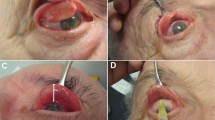Abstract
Background
Hang-back recession and botulinum toxin injection are performed as one treatment option for the correction of large angles of deviation. However, the effect of botulinum toxin on hang-back recession has not been thoroughly evaluated. The purpose of this study is to investigate the effect of botulinum toxin on the hang-back recession of extraocular muscles.
Methods
Under general anesthesia, 6-mm hang-back recession of the superior rectus muscle (SR) was performed in all eyes of 12 rabbits. Botulinum toxin (5 IU, 0.1 ml) was injected into the SR of one eye in each rabbit. The inferior rectus muscles (IR) of both eyes were excised to model severe paralysis. The distance between the superior limbus and the new insertion was measured immediately after the procedure and 3 months postoperatively. Changes in the location of the insertion were evaluated and compared between both eyes.
Results
After excision of the IR, upward deviation was observed in all eyes. The insertion site of the recessed SR immediately after the procedure and 3 months postoperatively were significantly different in all rabbit eyes with or without botulinum injection (P = 0.002, 0.002); SR advancement was observed in both cases. The amount of advancement was 1.38 ± 0.41 mm in the SR without botulinum toxin injection and 2.29 ± 0.45 mm in the SR with injection; this difference was statistically significant (P = 0.002).
Conclusions
Botulinum toxin injection reduced the amount of hang-back recession in deviated rabbit eyes. Surgeons should be aware that botulinum toxin can diminish the effects of hang-back recession when used simultaneously.

Similar content being viewed by others
References
Repka MX, Guyton DL (1988) Comparison of hang-back medial rectus recession with conventional recession. Ophthalmology 95:782–787
Rodrigues AC, Nelson LB (2006) Long-term results of hang-back lateral rectus recession. J Pediatr Ophthalmol Strabismus 43:161–164
Mills PV, Hyper TJ, Duff GR (1987) Loop recession of the recti muscles. Eye 1:593–596
Rajavi Z, Ghadim HM, Nikkhoo M, Dehsarvi B (2001) Comparison of hang-back and conventional recession surgery for horizontal strabismus. J Pediatr Ophthalmol Strabismus 38:273–277
Chung AK, Rehman SU, Bradbury JA (2005) Comparison of modified anchored “hang-back technique (HBT)” with conventional HBT in bimedial rectus recession. J AAPOS 9:234–239
Hemmerdinger C, Rowe N, Baker L, Lloyd IC (2005) Bimedial hang-back recession—outcomes and surgical response. Eye 19:1178–1181
Orlin A, Mills M, Ying GS, Liu C (2007) A comparison of hang-back with conventional recession surgery for exotropia. J AAPOS 11:597–600
Wright KW (2007) Color atlas of strabismus surgery. Springer, Berlin Heidelberg New York, pp 117–130
Climenhaga HW, Pearce WG (1984) Adjustable sutures: experimental assessment of final muscle position. Can J Ophthalmol 19:234–236
Wysenbeek Y, Wygnansk-Jaffe T, Rosner M, Spierer A (2004) Evaluation of superior rectus muscle attachment following hang-back recession in rabbit eyes. Eur J Ophthalmol 14:464–466
Ihtsuki H, Oshima K, Hasebe S, Kobashi R, Okano M, Furuse T (1994) Extraocular muscle surgery in a rabbit model: site of reattachment following hang0back and conventional recession. Graefes Arch Clin Exp Ophthalmol 232:689–694
Repka MX, Fishman PJ, Guyton DL (1990) The site of reattachment of extraocular muscle following hang-back recession. J Pediatr Ophthalmol Strabismus 27:286–290
Scott AB, Rosenbaum AL, Collins CC (1973) Pharmacological weakening of extraocular muscles. Invest Ophthalmol 12:924
Magoon EH (1994) Clinical use of botulinum toxin: clinical trials for strabismus. In: Jankovic J (ed) Therapy with botulinum toxin. Marcel Denker Inc, New York, pp 371–376
Criuch ER (2006) Use of botulinum toxin in strabismus. Curr Opin Ophthalmol 17:435–440
Ozkan SB, Topaloglu A, Aydin S (2006) The role of botulinum toxin A in augmentation of the effect of recession and/or resection surgery. J AAPOS 10:124–127
Khan AO (2005) Two horizontal rectus eye muscle surgery combined with botulunum toxin for the treatment of very large angle esotropia. A pilot study. Binocul Vis Strabismus Q 20:15–20
Author information
Authors and Affiliations
Corresponding author
Additional information
The authors have not received grant support or research funding, and do not have any proprietary interests in the materials described in the manuscript.
The authors have full control of all primary data, and agree to allow Graefe’s Archive for Clinical and Experimental Ophthalmology to review our data upon request.
Rights and permissions
About this article
Cite this article
Suh, YW., Park, JH. & Cho, Y.A. The effect of botulinum toxin injection on the hang-back recession of rectus muscles. Graefes Arch Clin Exp Ophthalmol 249, 921–924 (2011). https://doi.org/10.1007/s00417-011-1615-y
Received:
Revised:
Accepted:
Published:
Issue Date:
DOI: https://doi.org/10.1007/s00417-011-1615-y




